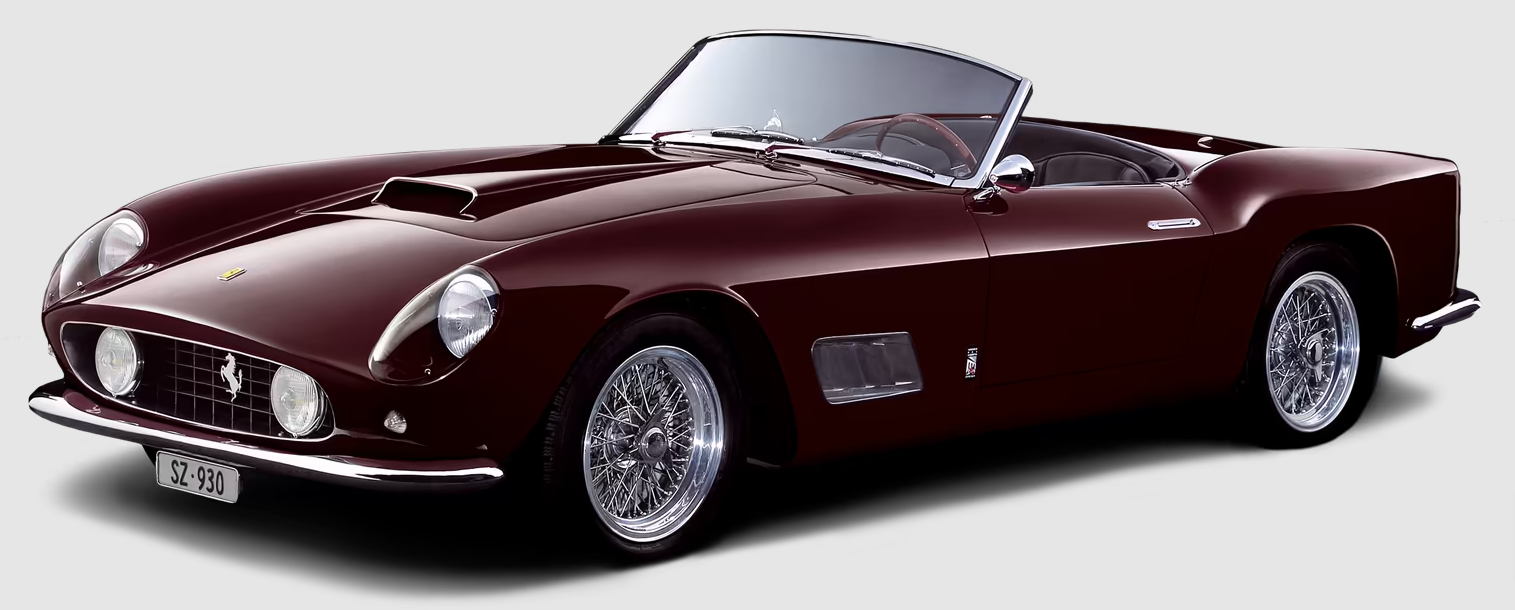
The term ‘spider’ in the model name is something of an anomaly, as the California is really a cabriolet or convertible, with a full folding hood. However, it was in effect an open-top version of the 250 GT Berlinetta alongside which it was produced. Thus, the term spider differentiated it from the concurrently produced 250 GT cabriolets, which were allied to the road-going 250 GT coupés. With two open cars in the production model line-up, it can be seen that open cars were in vogue at the end of the fifties. This model was constructed in two distinct series: the ‘LWB’ (long wheelbase) between 1958 and 1960, although a prototype was built in late 1957, and the ‘SWB’ (short wheelbase) from 1960 to 1962. The latter example wasn’t actually completed until early 1963, with sub-divisions relative to body and mechanical details. A removable hard-top was available for both series.
The body was to a Pininfarina design, and constructed mainly in steel with aluminium opening panels or occasionally completely in aluminium, by Scaglietti in Modena. The ‘LWB’ models were built on a 2600 mm wheelbase chassis, which had factory reference number 508C, and then 508D, as on the ‘TdF’ berlinettas.
All were numbered in the odd chassis number road car sequence carrying a ‘GT’ suffix, generally constructed along the same lines as those of the concurrent berlinettas, as were the mechanical components, like suspension, brakes, and steering, with all examples produced being left-hand drive. Visually, the early cars in the series were virtually pure berlinetta body in style from the waist down, only the windscreen, folding canvas roof, boot line, and door handles being different. During the production run of the ‘LWB’ model some changes were made in body details, like the shape and design of the front wing engine bay exhaust air vents, and more noticeably the rear wing line and lights, boot, and tail profile, which received a step in the panel projecting beyond the base of the lid on late series cars. Some examples were provided with covered headlights, and others with open units, the choice being in the client’s hands, apart from cars sold in Italy in 1959, where legislation at that time dictated open headlights. The very last cars in the series, produced in late 1959 and early 1960, were fitted with disc brakes to all four wheels, instead of the drum brake set-up of the earlier examples.
The bodies of the ‘SWB’ series of cars were very similar to those of the outgoing ‘LWB’ version, but were mounted on a new 2400 mm wheelbase chassis, that initially had factory reference number 539, and then 539/61, as on the concurrently produced ‘SWB’ berlinettas. The new chassis reduced the overall height of the car by 30 mm; although barely discernible, it gave the car a squatter appearance than the earlier versions, but they are still difficult to tell apart. The early ‘LWB’ models are easy to recognise because of their rear light units, which are as those fitted to the 250 GT berlinettas of the period, and their flush mounted door handles. The easiest way to distinguish a late ‘LWB’ from an ‘SWB’ is in the design of the bonnet air intake, which on an ‘LWB’ is proud of the bonnet line, whilst on the ‘SWB’ it rises from a depression in the bonnet line. The exhaust air outlet design on the front wings is also different: the ‘LWB’ has three vertical raised strips and the ‘SWB’ only two. As with the earlier ‘LWB’ variant, all ‘SWB’ examples were numbered in the odd chassis number road car sequence carrying a ‘GT’ suffix, were left-hand drive (despite the concurrent berlinetta being available as RHD), and were fitted with four wheel disc brakes.
The majority of ‘LWB’ cars had the single overhead camshaft per bank 3 litre V12 engine, with factory type references 128C and 128D, and a capacity of 2953 cc, with a bore and stroke of 73 mm x 58.8 mm, with spark plugs inside the vee of the block, to the same basic specification as the concurrent berlinettas. The early examples were fitted with a single coil and distributor ignition system, later replaced by a twin coil and distributor arrangement, to produce a claimed 260 bhp. The late series production ‘LWB’ examples and early ‘SWB’ series cars were fitted with the outside spark plug 3-litre V12 type 128 DF and 128 F engines, with twin coil and distributor ignition systems and larger carburettors. The later ‘SWB’ models were fitted with further developments of the 3-litre V12 engine, which were given the factory reference numbers 168 and then 168/61. These were also outside spark plug variants, with a twin coil and distributor ignition system layout. Within these general parameters certain engines received special treatment, with different camshafts, valve sizes, and carburettor set-ups, to boost the power output for competition use. The transmission was as that fitted to the concurrent ‘LWB’ and ‘SWB’ berlinetta series.
As noted relative to the engines, certain examples of both long and short wheel base cars had competition careers, probably due to a driver’s preference for an open GT car over a closed one, but maybe also to promote the model by use in competition. The American driver Bob Grossman was one of the most successful exponents in a 250 GT California in competition, with a fifth overall at Le Mans in 1959 partnered by Fernand Tavano, in ‘LWB chassis 1451 GT. He also had numerous good results in national races in the USA during 1959 and 1960 in this car.
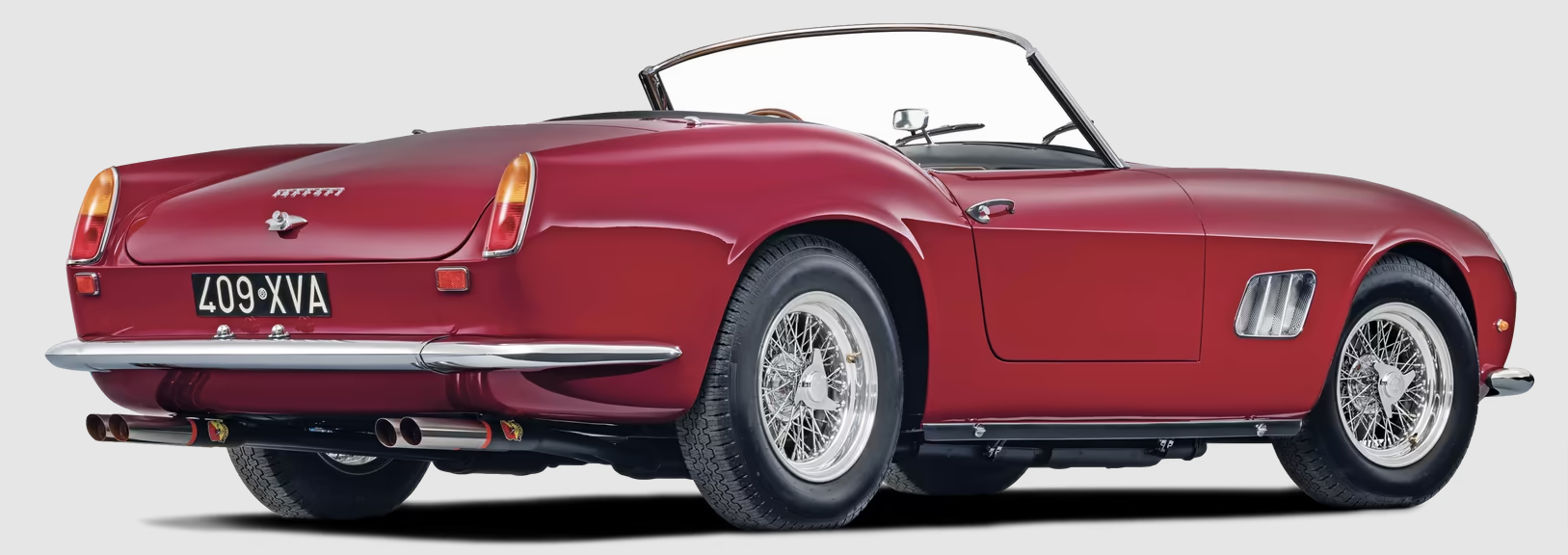
The Chassis
The bodies of the ‘SWB’ series of cars were very similar to those of the outgoing ‘LWB’ version, but were mounted on a new 2400 mm wheelbase chassis, that initially had factory reference number 539, and then 539/61, as on the concurrently produced ‘SWB’ berlinettas. The new chassis reduced the overall height of the car by 30 mm; although barely discernible, it gave the car a squatter appearance than the earlier versions, but they are still difficult to tell apart. The early ’LWB’ models are easy to recognise because of their rear light units, which are as those fitted to the 250 GT berlinettas of the period, and their flush mounted door handles.
The easiest way to distinguish a late ’LWB’ from an ’SWB’ is in the design of the bonnet air intake, which on an ’LWB’ is proud of the bonnet line, whilst on the ’SWB’ it rises from a depression in the bonnet line. The exhaust air outlet design on the front wings is also different: the ’LWB’ has three vertical raised strips and the ’SWB’ only two. As with the earlier ’LWB’ variant, all ’SWB’ examples were numbered in the odd chassis number road car sequence carrying a ’GT’ suffix. They were all were left-hand drive, with the exception of one car, and were fitted with four wheel disc brakes. As noted relative to the engines, certain examples of both long and short wheel base cars had competition careers, probably due to a driver’s preference for an open GT car over a closed one, but maybe also to promote the model by use in competition. The American driver Bob Grossman was one of the most successful exponents in a 250 GT California in competition, with a fifth overall at Le Mans in 1959 partnered by Fernand Tavano, in ‘LWB chassis 1451 GT. He also had numerous good results in national races in the USA during 1959 and 1960 in this car.
The Engine
The majority of ‘LWB’ cars had the single overhead camshaft per bank 3 litre V12 engine, with factory type references 128C and 128D, and a capacity of 2953 cc, with a bore and stroke of 73 mm x 58.8 mm, with spark plugs inside the vee of the block, to the same basic specification as the concurrent berlinettas. The early examples were fitted with a single coil and distributor ignition system, later replaced by a twin coil and distributor arrangement, to produce a claimed 260 bhp.
The late series production ‘LWB’ examples and early ’SWB’ series cars were fitted with the outside spark plug 3-litre V12 type 128 DF and 128 F engines, with twin coil and distributor ignition systems and larger carburettors. The later ’SWB’ models were fitted with further developments of the 3-litre V12 engine, which were given the factory reference numbers 168 and then 168/61. These were also outside spark plug variants, with a twin coil and distributor ignition system layout. Within these general parameters certain engines received special treatment, with different camshafts, valve sizes, and carburettor set-ups, to boost the power output for competition use. The transmission was as that fitted to the concurrent ‘LWB’ and ’SWB’ berlinetta series.
Production
|
Series
|
Years
|
|---|---|
|
LWB
|
1958–1960
|
|
SWB
|
1960–1963
|
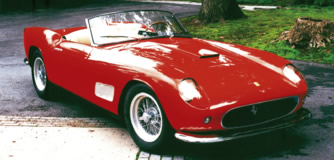 Engine
Engine
- Type front, longitudinal 60° V12
- Bore/stroke 73 x 58.8 mm
- Unitary displacement 246.10 cc
- Total displacement 2953.21 cc
- Compression ratio 8.5 : 1
- Maximum power 176 kW (240 hp) at 7000 rpm
- Power per litre 81 hp/l
- Valve actuation single overhead camshaft per bank, two valves per cylinder
- Fuel feed three Weber 36 DCL carburettors
- Ignition single spark plug per cylinder, two coils
- Lubrication wet sump
- Clutch twin-plate
 Chassis
Chassis
- Frame tubular steel
- Front suspension independent, unequal-length wishbones, coil springs,hydraulic shock absorbers
- Rear suspension live axle, semi-elliptic springs, hydraulic shock absorbers
- Brakes drums
- Transmission 4-speed + reverse
- Steering worm and sector
- Fuel tank capacity 100 litres
- Front tyres 6.00 x 16
- Rear tyres 6.00 x 16
 Bodywork
Bodywork
- Type two-seater spider
- Wheelbase 2600 mm
- Front track 1354 mm
- Rear track 1349 mm
- Weight 1100 kg (dry)
Performance
- Top speed 252 km/h
Gallery
THE FERRARI 250GT SERIES 1 CABRIOLET
It is to the emergent, dynamic and at the time only two-year-old Italian coachbuilding company, Carrozzeria Boano, that credit should go for reviving 1950s interest in Cabriolet convertible coachwork upon Ferrari chassis. The very first 250 GT Cabriolet was built by Boano in time for the 1956 Geneva Salon de l’Automobile exhibition. Its unveiling there coincided with that of the first Ferrari to launch genuine series production – a Pinin Farina Coupe built in a small production series by the same Boano company.
Boano’s Cabriolet was subsequently displayed by Luigi Chinetti – Ferrari’s legendary American East Coast importer – at the New York Show. The car found a ready buyer, and meantime Pinin Farina had taken notice of interest in these convertible cars, producing its own Cabriolet that was launched to the public at the following year’s Geneva Salon, in March 1957. This very functional and rather sporty-looking styling exercise featured a functional notch in the crest of the left-side door, to give space for the driver’s elbow while the waistline thereafter kicked-up into the rear fender peak. While that dream car was finished in Italian red for its debut, it was quickly resprayed green and became Ferrari’s British works driver Peter Collins’s personal car. It was subsequently fitted by Dunlop with British-made disc brakes – and they in turn would be adapted one day to enhance a works-team Testa Rossa sports-racing machine.
Pinin Farina continued to develop the notion of a 3-litre V12-engined Ferrari Cabriolet, first with a rather exotic and even more sporty-looking Spyder, followed by a more sober prototype street version. The group of four Speciale 250 GT Cabriolet prototypes finally culminated in a green-finished example, sold to Prince Saddrudin Aga Khan in May 1957.
The first ‘true production’ 250 GT Cabriolet Pinin Farina was then delivered in mid-summer 1957 to American, Mr Oscar ‘Ozzie’ Olson, later sponsor of the Indy-racing Olsonite Eagles. His Cabriolet’s flanks were devoid of the air vents that had adorned the preceding prototypes, and this more discreet style was adopted for the vast majority of the 20-plus examples which quickly followed.
The basis of these early Cabriolets was the same chassis frame/engine aggregate which had under-pinned the 1956-58 Coupe cars. During the summer of 1958 a new, more sporting convertible was introduced as the 250 GT California, but the Series 1 Cabriolet, such as the simply outstanding example offered here, remained the open street Ferrari of choice for the truly discriminating, and perhaps temperamentally less extrovert, less flamboyant, more discreet of Ferrari’s contemporary, up-market, clientele

1958 Ferrari 250 GT Series 1 Cabriolet, Coachwork by Carrozzeria Pinin Farina (Chassis no. 0759 GT)
This particularly magnificent Ferrari 250 GT Cabriolet S1 Pinin Farina is chassis serial ‘0759 GT’. It is a very early example, being only the eighth of some 40 units built overall. Its chassis frame was delivered to the Pinin Farina plant on September 9, 1957, and upon its completion with this strikingly handsome body it was promptly (and so justifiably) exhibited at the 39th Salone dell’Automobile in Turin’s Valentino Park exhibition hall, from October 30-November 10 that year.

1959 Ferrari 250 GT LWB California Spider with coachwork by Scaglietti, chassis no. 1451 GT
The second of only eight aluminum-bodied Ferrari 250 GT LWB California Spider Competizione examples ever produced, chassis no. 1451 GT, boasts an impeccable Le Mans history and represents one of the most significant competition Ferraris extant. It is the first California Spider equipped from the factory with the competition-specification, outside-plug Type 128 F engine, among numerous other rare competition features including a Type 508 D ribbed gearbox, a 9.6:1 compression ratio resulting in 262.5 horsepower, an external oil cooler, stiffer suspension, and a long-range, 35-gallon fuel tank with an external fuel filler cap.
The car was completed on June 15, 1959, a mere five days before the 1959 24 Hours of Le Mans, where it was campaigned by Luigi Chinetti’s N.A.R.T. in the hands of its first owner, American car dealer and gentleman racer Robert “Bob” Grossman and co-driver Fernand Tavano. This hurried finish, nor the fact that it was Grossman’s first race at Le Mans, did not stop him from achieving the single most successful result in a 250 GT California Spider in competition, securing a remarkable fifth-place overall finish and third in the GT Class at Le Mans.
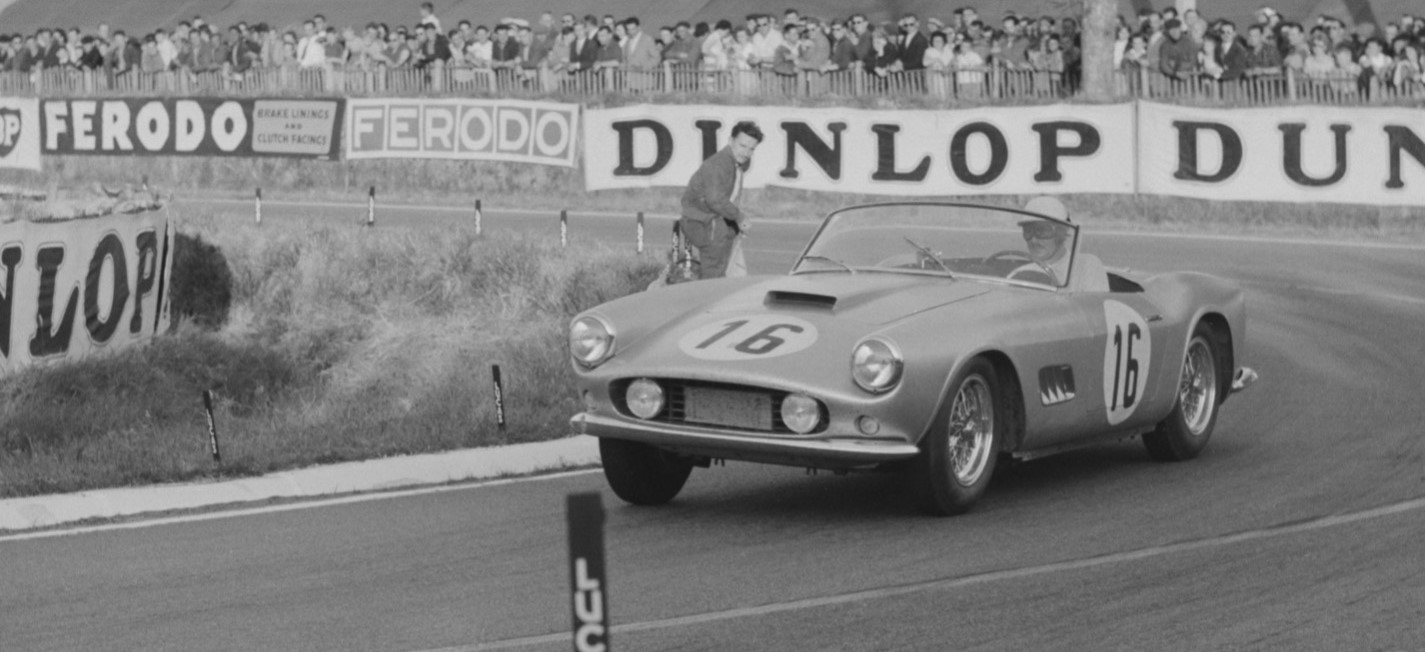



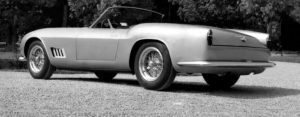
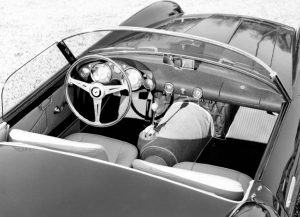
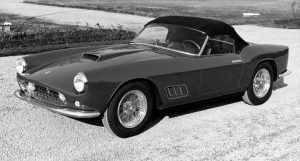

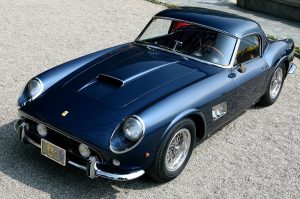
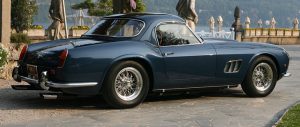

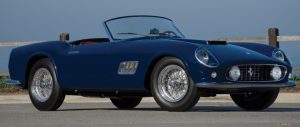
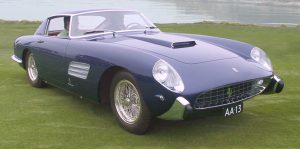
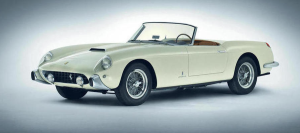
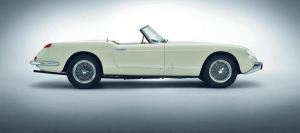
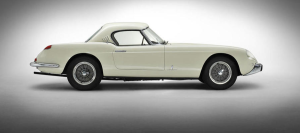
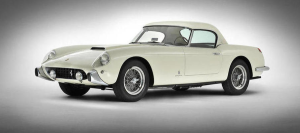


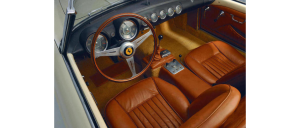
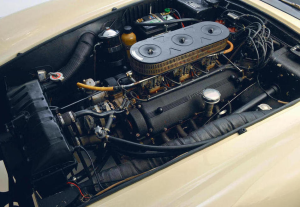

You must be logged in to post a comment.